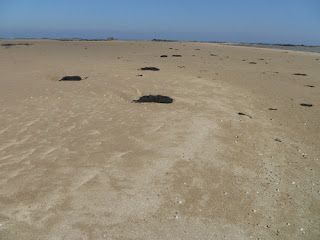Low Tide Exploration
On one of the warmest days of the year, combined with one of the largest tides a sea kayaking trip should have been the order of the day but work commitments got in the way. But what better alternative than exploring Jersey's unique environment, off the south east corner of the Island.
As the spring tide retreats a unique landscape is revealed, a mixture of shingle, sand, rocks etc are exposed for up to two miles from the shore. The importance of this area is recognized by the fact that it was the first Ramsar site to be designated in Jersey, in November 2000.
A favourite destination for low water fishermen, I was surprised how few other people were in the area, considering the weather. A great way to spend the last Tuesday afternoon in September 2011.
Looking north towards Gorey and its spectacular castle just after we left the Seymour Slip.
Approaching Seymour Tower. Built in 1782, it was named after General Seymour Conway, the Governor of the Island.
Looking south east from the Tower there was still a considerable distance to go to the waters edge. Unfortunately we were too late leaving to head much further out.
The shadow of the tower points towards the east coast of the Island.
The rocks in the distance are the Petite and Grande Anquette. An interesting sea kayaking trip to an isolated part of Jersey's coastal waters.
Looking west along the south coast of Jersey, exposed rocks as far as the eye can see.
Seymour Tower viewed from the south. The concrete additions on top are as a result of the German occupation of the Island.
The dried seaweed indicates the direction of the tidal flow as the banks dried.
One of the larger sand banks.
We paid a visit to Little Seymour, as we headed back towards Jersey.
This is an area which is not without economic worth. These are oyster beds but there are also significant areas of mussels.











No comments:
Post a Comment